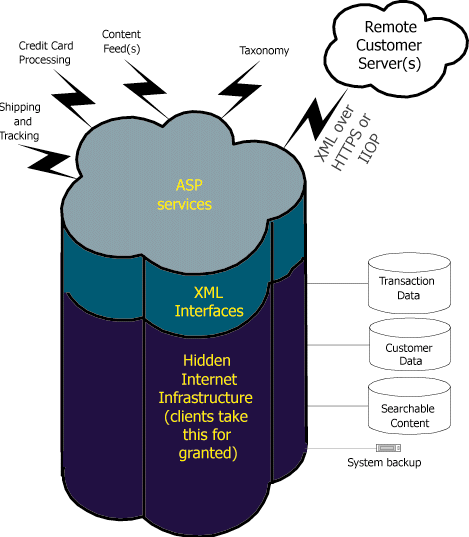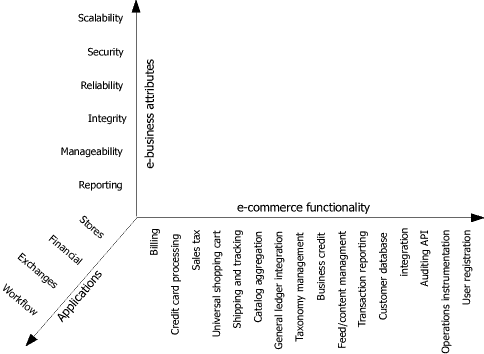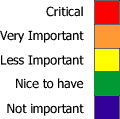Published 1999-06-12.
Last modified 2020-08-24.
Time to read: 9 minutes.
mentoring & advising collection.

The vast majority of startups never last beyond two years. What does it take to succeed? This article approaches startup survival and success from a technical management perspective.
Simply mouthing the words of the latest technology trend may be fashionable and may help get the attention of those that you want to impress. After others look more closely and realize that the message doesn’t correspond to action, the first impression becomes negative. “Walk your talk” is actually a difficult precept to live up to.
In a startup, formulating business objectives is a real challenge, as is developing a technological strategy to support those objectives. Following through and measuring progress is especially difficult.
Top Ten Points For Managing Startups
- Continuously clarify and communicate the business vision.
- Set near-, medium- and long-term goals to support the vision.
- Ensure that every person understands how their every action supports the vision, and eliminate actions that do not.
- Empower each person to fulfill their component(s) of the vision.
- Make each person accountable for their results. Managers are accountable to their superiors AND their subordinates. The president/CEO is accountable to everyone. The issue for management personnel is integrity, for without it the organization sags.
- Realize that mistakes happen when someone is attempting to accomplish something new or significant in scope or timeframe; ‘safe’ behavior might be dysfunctional in a start-up. Mistakes are inevitable, but they can be of great value if individuals and the organization learn rapidly.
- Only a true team can win. Individual contributors, no matter how stellar, cannot sustainably grow a high-tech startup to a high valuation.
- A high-tech company’s assets are its people, not its technology or equipment. This is the asset that investors value, managers cultivate, and the reason stock options are provided. A high-tech company should continuously measure its turnover rate and learn from each departure.
- Unless you are building a vertically integrated empire like Amazon, buy instead of building whenever possible. Most companies cannot afford to have the “not invented here” syndrome. Choosing a technological playing field and leveraging customizable software platforms is necessary for a company to maintain a position on the leading edge.
- Foster mutually rewarding relationships. Long-term relationships based on a win-win philosophy are simply more feasible and profitable.
Some definitions
- Vision
- Setting a stake in the ground and, in advance of the company’s ability to perform, describing how the company will address a future, hypothetical market.
- Brand
- Brand is more than being top of mind for a target audience it is also about presenting a clear message that invites utilization by the target audience. Competitive analysis, profitability projections and a solid positioning statement must precede the branding exercise.
- Communication
- Recognizing that all employees can provide valuable insight when included in ongoing discussions, be they regarding corporate finances, sales opportunities, operations, technical strategy, technology development and strategic alliances. Communication requires an uncommon ability to listen and accept ideas from others, and a willingness to take the time to organize the information such that it becomes suitable for posting on the corporate intranet, brochures, presentations, or other forums. A timely posting of the information must be the norm, or walls will go up between groups of people; the ‘insiders’ and the ‘outsiders’.
- Teams
- Teams don’t have outsiders; everyone on the team is an insider and an equal.
- Goals
- Establishing future activities, capabilities and performance levels. Goals are only useful when progress towards them can be continuously measured. Action must be prompt when measurements indicate a drifting off target, that the risk of not achieving the goal is steadily increasing, or that the goal is no longer relevant.
- Leadership
- Inspiring others to work towards common goals.
Consistency in word and action is essential, day in and day out. Hypocrisy or
opportunistic reprioritization is a good way for a person to destroy their
effectiveness as a leader. Leading by example is the only true leadership.
Learn from departing individuals; was the departing individual:- …somehow inappropriate? If so, how can this be prevented or mitigated for future hires? Is there a way that their performance can be continuously measured, and action taken if required?
- …not recognized? Perhaps they voiced their opinion, and it was not acted upon. Perhaps their contribution was not appreciated. Different people need to be recognized in ways that resonate with them. For many, a cash bonus is appreciated. For others, it’s a public thank-you. Still others appreciate time off, etc.
- …overworked? Burnout is a common phenomenon, and can lead to bitterness.
- …demoralized by constantly changing priorities? Changes that appear to be arbitrary are demoralizing.
- …disempowered?
Case Study
An Internet startup’s CEO had struggled to keep the company going through its first two years of existence. His role was to convince prospects that they should purchase software and support services from the startup. The CTO’s job was to create the products that the CEO had sold. By working very hard, through fierce dedication and long hours, the two men (assisted by subcontractors) created some interesting technology.
They had two problems: the technology they had created was not so much designed as kludged, and they had no business goals. No prospect was ever told, “That’s not the business we are in.” They behaved as if every prospect was their last opportunity. The result of stretching to meet every prospect’s wishes meant that the startup’s code was wide in scope and deep in a few areas, but it was not documented.
A further complication was that they loved to write code. Like many technical people, they got their principal enjoyment from making things and not from learning how to efficiently serve the needs of a target market. The result was that they re-invented many wheels, duplicating much of what was present in commercial off-the-shelf development environments. This cost them time and energy to build and constantly diverted their attention from satisfying their customers. Instead of being able to ride the technology wave by obtaining the latest upgrade from their software tool vendors, this company, like many technically oriented companies, found themselves falling behind due to the burden of the wheels that they had re-invented.
Internet companies have been enjoying rather large valuations. The CEO saw the trend to provide information technology for a monthly fee as something very lucrative, and he knew that investors were searching for those types of companies to invest in. Wealth and fame were the two motivating factors for him to decide on the startup’s new business direction.
The company’s needs were to:
- understand what the market required from an ASP
- assess the startup’s technical abilities as an ASP
- have the technical, sales and marketing staff work together to develop the business plan and an initial marketing message
- map out a technical strategy to support the business plan
- estimate a timeline, costs and identify risks
In the end, they concluded that the market opportunity was indeed great, the startup could probably come to market in three to four months, a viable business plan could be formulated, a technical strategy was not difficult, and implementation costs were within current cash flow. There was a problem, and an insurmountable one: the CEO and the CTO didn’t enjoy the type of work that the business plan required. They were simply the wrong people for the job. This assignment was clearly a non-starter.
Let’s look at how they came to this conclusion.
The Rise of ASPs
Application Service Providers (ASPs) are looked upon as the darlings of the Internet marketplace; they enable new businesses to quickly take advantage of vertical market opportunities. Time is the key element for today’s e-business – and building and managing the complex software and hardware infrastructure necessary to run e-business is best outsourced to ASPs with proven expertise.
There are two types of ASPs: those that develop their technology and those whose expertise is in running and operating commercial products, such as Oracle, SAP, PeopleSoft, etc.
ASPs host applications, so their clients can outsource those operations. The main attractions for clients are time and money savings.

An ASP’s customers either subscribe to a dedicated server in the ASP’s server farm or communicate with the farm via a secure link over the Internet. The communication often consists of XML requests and might use the HTTP or IIOP protocols. The set of services that the ASP exposes to the customer allow the customer’s software to initiate and track shipments, interact with the billing service, charge credit cards and review transactions, perform searches and retrieve specialized content, and serve up catalogs to end users.
Underpinning all these interfaces is a set of services that provides the e-commerce attributes first mentioned: scalability, security, reliability, integrity, manageability and reporting. Customers don’t have to worry about backing up the data, hackers gaining entry, peak usage overload, and the other technically challenging issues that e-commerce administrators must face. The ASP’s engineers and system operators ensure that the system works continuously, securely, and adequate capacity is available to service end users.
Understanding Today’s E-Business Needs
The would-be ASP viewed their potential service along three axes: applications, e-commerce attributes, and e-business functions. This three-dimensional space describes features and benefits to emerging e-businesses and considers the client’s expertise and worldview. This model is therefore not complete enough to be applicable without any modification to other ASPs.

As you can see, the vertical axis (labeled e-commerce attributes) has as major components scalability, security, reliability, integrity, manageability and reporting. Each of these broad adjectives is broken down into the key features found in each of the e-business functions found on the horizontal axis.
The horizontal axis, labeled e-business functions, has the following major interfaces available to the ASP’s clients: billing, credit card, sales tax, universal shopping cart, shipping and tracking, catalog aggregation, general ledger integration, taxonomy management, business credit, order entry, data feed/content management, transaction reporting, customer database integration, and auditing. Each interface is implemented using XML, and plans are underway to provide programmable interfaces for EJB, JSP and IIS ASP.
On the third axis, the ASP combines the e-commerce attributes and e-business functionality and addresses specific applications such as auctions, retail stores, financial businesses (such as mortgages), and various business-to-business vertical markets. ASPs have recognized that many vertical business-to-business opportunities have similar characteristics and are developing generic interfaces for clearing houses/exchanges and workflow management.
Addressing Specific Markets

Now that they had a broad understanding of all possible ASP services, they realized that to attempt to cover the entire matrix for even one industry segment was a huge job. They then set out to characterize some opportunities that they were aware of so that they could then match their technical requirements against current in-house technical ability. They used the color-coded legend (left) to display the relative importance of each characteristic for the opportunity under consideration.
The following diagram shows the relative importance of each characteristic for an online opportunity that must remain anonymous. As you can see, it obviously isn’t a business-to-business opportunity:

The hot e-commerce issues for this opportunity (in order of importance) can easily be seen: user registration, operations instrumentation, feed/content management, and credit card processing, followed by transaction reporting and customer database issues. The hot e-business features are scalability and security, reliability and integrity, manageability and reporting. They then listed out the manpower necessary to develop the service capacity and operate the systems 24 hours a day, 7 days a week.
They looked briefly at a few more opportunities and made color-coded feature maps. Although each map was unique, one common feature stood out: ASPs are primarily systems integrators, and the majority of their investment lies in operations.
The startup’s principals didn’t want to hear this, since they loved to create neat stuff that hopefully someone would want to buy. The sexiest attribute of ASPs is probably their balance sheet, and the less technology an ASP has to support, the more profitable they will be. Yet, the evidence can’t be argued with; if you want to be an ASP, your focus must be on daily operations, not R&D. Another nail in the coffin of the startup’s ASP aspirations was that they really had no expertise with any commercial software products. Sure, they could learn, but they were not motivated to do so.
Conclusion
We can all take away a lesson from this story. No matter how good a business plan and timing a company may have, the skills and interests of the principals must coincide with the task at hand. If the hearts of the people involved lie elsewhere, they will not execute to plan. A plan is just a piece of paper unless it fires the imaginations of those who must act on it.











